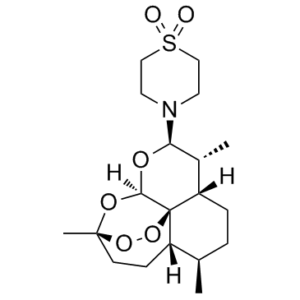Artemisone (also known as BAY-44-9585, BAY-449585, and Artemifone) is a novel, potent and semi-synthetic antimalarial agent that inhibits P. falciparum strains, with a mean IC50 of 0.83 nM. Artemisone was 10 times more potent than artesunate in vitro against a panel of 12 P. falciparum strains, independent of their susceptibility profile to antimalarial drugs, and consistently 4 to 10 times more potent than artesunate in rodent models against drug-susceptible and primaquine- or sulfadoxine/pyrimethamine-resistant Plasmodium berghei lines and chloroquine- or artemisinin-resistant lines of Plasmodium yoelii. Slight antagonistic trends were found between artemisone and chloroquine, amodiaquine, tafenoquine, atovaquone or pyrimethamine and additive to slight synergistic trends with artemisone and mefloquine, lumefantrine or quinine. Various degrees of synergy were observed in vivo between artemisone and mefloquine, chloroquine or clindamycin.
Physicochemical Properties
| Molecular Formula | C19H31NO6S |
| Molecular Weight | 401.51754 |
| Exact Mass | 401.187 |
| Elemental Analysis | C, 56.84; H, 7.78; N, 3.49; O, 23.91; S, 7.98 |
| CAS # | 255730-18-8 |
| PubChem CID | 11531457 |
| Appearance | White to off-white solid powder |
| LogP | 2.595 |
| Hydrogen Bond Donor Count | 0 |
| Hydrogen Bond Acceptor Count | 7 |
| Rotatable Bond Count | 1 |
| Heavy Atom Count | 27 |
| Complexity | 696 |
| Defined Atom Stereocenter Count | 8 |
| SMILES | C[C@@H]1CC[C@H]2[C@@H](C)[C@H](N3CCS(=O)(=O)CC3)O[C@H]4[C@@]25[C@H]1C[C@](C)(CO4)OO5 |
| InChi Key | FDMUNKXWYMSZIR-NQWKWHCYSA-N |
| InChi Code | InChI=1S/C19H31NO6S/c1-12-4-5-15-13(2)16(20-8-10-27(21,22)11-9-20)23-17-19(15)14(12)6-7-18(3,24-17)25-26-19/h12-17H,4-11H2,1-3H3/t12-,13-,14+,15+,16-,17-,18-,19-/m1/s1 |
| Chemical Name | 4-((3R,5aS,6R,8aS,9R,10R,12R,12aR)-3,6,9-Trimethyldecahydro-12H-3,12-epoxypyrano(4,3-j)(1,2)benzodioxepin-10-yl)thiomorpholine-1,1-dione |
| Synonyms | Artemifone; Artemisone; BAY-44-9585; BAY44-9585; BAY 44-9585; BAY-449585; BAY 449585; BAY449585. |
| HS Tariff Code | 2934.99.9001 |
| Storage |
Powder-20°C 3 years 4°C 2 years In solvent -80°C 6 months -20°C 1 month |
| Shipping Condition | Room temperature (This product is stable at ambient temperature for a few days during ordinary shipping and time spent in Customs) |
Biological Activity
| Targets | Plasmodium |
| ln Vitro | With IC50s of 0.88±0.59 and 1.23±0.64 nM, respectively, artemisone inhibits 3D7 and K1 P. falciparum[1]. |
| ln Vivo | Artemisone has an effective ED50 of 9.62 mg/kg when administered subcutaneously and 11.67 mg/kg when administered orally in the P. berghei NY susceptible strain. When used with other antimalarials, artemisone (3, 1, 0.3, and 0.1 mg/kg, s.c.) has a greater effect against the chloroquine-resistant line P. yoelii NS.[1] |
| References |
[1]. Antimalarial efficacy and drug interactions of the novel semi-synthetic endoperoxide artemisone in vitro and in vivo. J Antimicrob Chemother. 2007 Apr;59(4):658-65. [2]. Anti-SARS-CoV-2 Potential of Artemisinins In Vitro. ACS Infect. Dis. 2020 Jul. |
| Additional Infomation | Artemisone is under investigation in clinical trial NCT00936767 (Artemisone for the Treatment of Uncomplicated Falciparum Malaria in Western Cambodia). |
Solubility Data
| Solubility (In Vitro) | DMSO : ~130 mg/mL (~323.77 mM) |
| Solubility (In Vivo) |
Solubility in Formulation 1: ≥ 2.17 mg/mL (5.40 mM) (saturation unknown) in 10% DMSO + 40% PEG300 + 5% Tween80 + 45% Saline (add these co-solvents sequentially from left to right, and one by one), clear solution. For example, if 1 mL of working solution is to be prepared, you can add 100 μL of 21.7 mg/mL clear DMSO stock solution to 400 μL PEG300 and mix evenly; then add 50 μL Tween-80 to the above solution and mix evenly; then add 450 μL normal saline to adjust the volume to 1 mL. Preparation of saline: Dissolve 0.9 g of sodium chloride in 100 mL ddH₂ O to obtain a clear solution. Solubility in Formulation 2: ≥ 2.17 mg/mL (5.40 mM) (saturation unknown) in 10% DMSO + 90% (20% SBE-β-CD in Saline) (add these co-solvents sequentially from left to right, and one by one), clear solution. For example, if 1 mL of working solution is to be prepared, you can add 100 μL of 21.7 mg/mL clear DMSO stock solution to 900 μL of 20% SBE-β-CD physiological saline solution and mix evenly. Preparation of 20% SBE-β-CD in Saline (4°C,1 week): Dissolve 2 g SBE-β-CD in 10 mL saline to obtain a clear solution. Solubility in Formulation 3: ≥ 2.17 mg/mL (5.40 mM) (saturation unknown) in 10% DMSO + 90% Corn Oil (add these co-solvents sequentially from left to right, and one by one), clear solution. For example, if 1 mL of working solution is to be prepared, you can add 100 μL of 21.7 mg/mL clear DMSO stock solution to 900 μL of corn oil and mix evenly. Solubility in Formulation 4: 10% DMSO+40% PEG300+5% Tween-80+45% Saline: ≥ 2.17 mg/mL (5.40 mM) (Please use freshly prepared in vivo formulations for optimal results.) |
| Preparing Stock Solutions | 1 mg | 5 mg | 10 mg | |
| 1 mM | 2.4905 mL | 12.4527 mL | 24.9054 mL | |
| 5 mM | 0.4981 mL | 2.4905 mL | 4.9811 mL | |
| 10 mM | 0.2491 mL | 1.2453 mL | 2.4905 mL |
